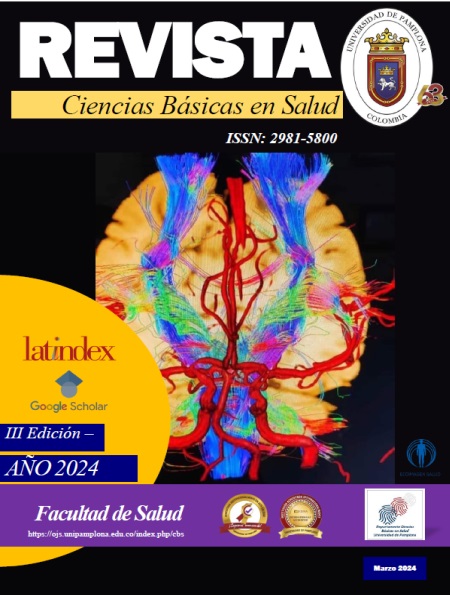Síndrome de Burnout en estudiantes del programa de fisioterapia de la Universidad de Pamplona que cursan prácticas clínicas
DOI:
https://doi.org/10.24054/cbs.v2i1.2773Palabras clave:
Inventario de Burnout de Maslach, estudiantes, síndrome de burnoutResumen
Objetivo: Determinar la incidencia y características del síndrome de Burnout en estudiantes del programa de fisioterapia de la Universidad de Pamplona que cursan prácticas clínicas. Metodología: El presente articulo reporta los resultados de una investigación cuantitativa, prospectiva, de tipo transversal, y según el análisis y alcance de datos es descriptiva y observacional. La población la conforman los estudiantes del programa de Fisioterapia con matrícula académica vigente de la universidad de Pamplona desde Sexto a Décimo semestre que cursan prácticas clínicas de niveles I, II, III, IV y CAP respectivamente para un total de 123 estudiantes. Se cuenta con una muestra de 94 estudiantes. Resultados: Para la dimensión de agotamiento el 49% de los estudiantes obtuvo una calificación entre alto y muy alto y asimismo el promedio fue de 15 puntos, que corresponde a un nivel alto, lo cual hace referencia a que hay indicios del Síndrome de Burnout. Para la dimensión de cinismo el 19% de los estudiantes obtuvo una calificación alta y el promedio fue de 6 puntos que indica un nivel “medio alto”, siendo este un indicativo de que no hay indicios del Síndrome de Burnout. Y en cuanto a la dimensión de eficacia académica el 19% de los participantes estuvo entre las puntuaciones bajo y muy bajo, y la puntuación promedio corresponde a 26, siendo este un nivel “medio bajo”, indicativo de que no hay indicios del Síndrome de Burnout. Conclusión: Esta investigación ha proporcionado información valiosa sobre la incidencia y características del síndrome de Burnout en estudiantes de fisioterapia durante sus
prácticas clínicas. Los resultados pueden ser útiles para implementar estrategias de prevención y apoyo emocional en este grupo específico de estudiantes. No obstante, es necesario considerar las limitaciones del estudio, como falta de comparaciones con investigaciones similares desarrolladas en el contexto colombiano, para comprender completamente el alcance de los resultados y su generalización.
Descargas
Referencias
Araoz, E. G. E., Ramos, N. A. G., & Uchasara, H. J. M. (2021). Burnout académico en estudiantes universitarios peruanos. Apuntes universitarios, 11(2), 48-62.
Bastidas, C. D. R. C., Ceballos, O. O. D., & Delgado, L. O. (2011). Síndrome de Burnout en estudiantes de pregrado de la universidad de Nariño. Revista Electrónica de Psicología Iztacala, 14(4), 223-246.
Caballero, C. C., Esteve, E. B., & Gutiérrez, O. G. (2015). Burnout in university students. Psicología desde el Caribe, 32(3).
Caballero, C. C., Hederich, C., & García, A. (2015). Relación entre burnout y engagement académicos con variables sociodemográficas y académicas. Psicología desde el Caribe, 32(2), 254-267.
Hederich-Martínez, C., & Caballero-Domínguez, C. C. (2016). Validation of Maslach Burnout Inventory-Student Survey (MBI-SS) in Colombian academic context. CES Psicología, 9(1), 1-15.
Liu, Z., Xie, Y., Sun, Z., Liu, D., Yin, H., & Shi, L. (2023). Factors associated with academic burnout and its prevalence among university students: a cross-sectional study. BMC Medical Education, 23(1), 317.
March-Amengual, J. M., Cambra Badii, I., Casas-Baroy, J. C., Altarriba, C., Comella Company, A., Pujol-Farriols, R., ... & Comella Cayuela, A. (2022). Psychological distress, burnout, and academic performance in first year college students. International journal of environmental research and public health, 19(6), 3356.
Martínez, I. M. M., Esteve, E. B., Gumbau, S. L., & Gumbau, R. G. (2005). Bienestar psicológico en estudiantes universitarios: facilitadores y obstaculizadores del desempeño académico. Annales De Psicología/Annals of Psychology, 21(1), 170-180.
Maslach, C., Jackson, S. E., & Leiter, M. P. (1997). Maslach burnout inventory. Scarecrow Education.
Merchán-Galvis, Á. M., Albino Matiz, A. Y., Bolaños-López, J. E., Millán, N., & Arias-Pinzón, A. A. (2018). Síndrome de Burnout y factores asociados en estudiantes de Medicina. Educación Médica Superior, 32(3), 172-180.
Morales-Rodríguez, F. M., Pérez-Mármol, J. M., & Brown, T. (2019). Education burnout and engagement in occupational therapy undergraduate students and its associated factors. Frontiers in psychology, 10, 2889.
Obregon, M., Luo, J., Shelton, J., Blevins, T., & MacDowell, M. (2020). Assessment of burnout in medical students using the Maslach Burnout Inventory-Student Survey: a cross-sectional data analysis. BMC medical education, 20(1), 1-10.
Schaufeli, W. B., Martinez, I. M., Pinto, A. M., Salanova, M., & Bakker, A. B. (2002). Burnout and engagement in university students: A cross-national study. Journal of cross-cultural psychology, 33(5), 464-481.
Descargas
Publicado
Número
Sección
Licencia
Derechos de autor 2024 Revista Ciencias Básicas en Salud

Esta obra está bajo una licencia internacional Creative Commons Atribución-NoComercial 4.0.







